Earlier this week, we made the Sensics Goggles for Public VR available for purchase on the OSVR Store. This is a limited pre-production run as we gear up for production of larger quantities.
We designed this product to address the needs of those that operate VR in public places such as theme parks, entertainment venues and shopping malls.
Goggles for public VR have different requirements than goggles for home use just like an exercise treadmill at a gym or health club needs to be different than a treadmill at home. Specifically, goggles for public VR need to be:
- Durable, so that they withstand use by a large number of people. Unlike users of a VR goggle at home, users of a VR goggle at a public place might care less about handling it carefully.
- Easy to clean, so that every user can get a clean, fresh feeling when wearing the goggles, regardless of who wore it before them.
- Easy to maintain, in case something breaks.
- Designed to allow maximum throughput of guests so as to maximize the number of people that can experience the attraction.
At the same time, the visual experience needs to be at least as good as goggles for home use because guests typically expect an experience beyond what they can get at home.
To achieve these goals, we used mass-produced 2160x1200 90 Hz OLED screens, high-quality dual-element optics with individual focusing mechanism, accurate 9-axis orientation tracker and incorporated them into a novel, patent-pending design. Below are some of the highlights of this design. To illustrate them, we mostly use the CAD drawings because they make it easy to show internal parts.
Here is CAD model of the entire unit (each part is colored differently in this model to make them stand out) next to the actual unit:
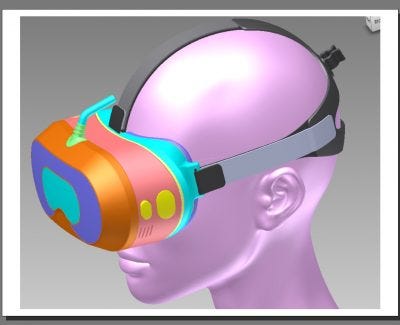
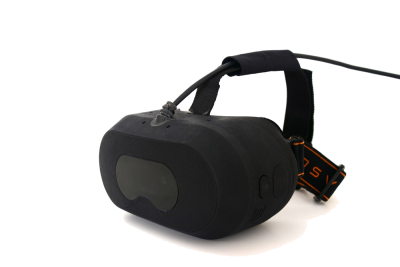
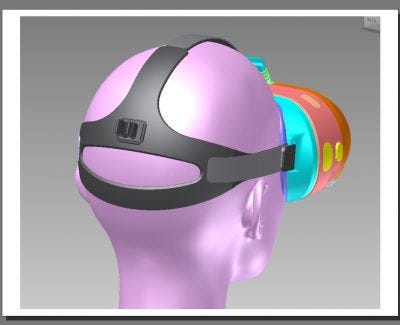
The back side of the unit has a cable clip to allow easy insertion and removal of cables as required. This ensures that cables don’t get in the way of the user.
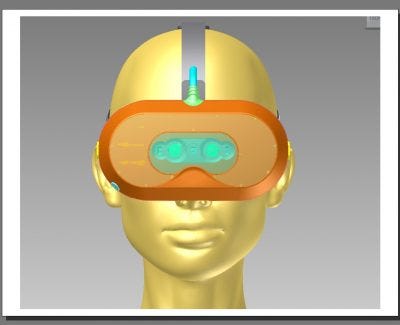
The front of the unit includes a window that is transparent to IR. This allows inclusion of a Leap Motion camera inside the unit to facilitate natural interaction with the hands. The fact that the controller is embedded inside the goggle eliminates the need to route cables externally. This approach is superior to external mounting of the controller because when mounted externally, the controller might be easier to detach from the goggles. Note that in the CAD model, the IR window has been removed so that the Leap Motion unit is clearly visible.
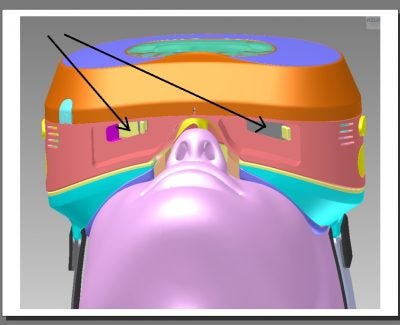
To fit a wide range of users, the goggles were designed with adjustable optics. These allow people that normally wear eyeglasses to take them off and still see an excellent picture. Individual knobs — highlighted by the arrows in the CAD drawing from a bottom view perspective
- allow focusing of each eye independently. It is also possible to design optics that have a large enough eye relief to accommodate glasses but we chose adjustments in this particular design.
- allow focusing of each eye independently. It is also possible to design optics that have a large enough eye relief to accommodate glasses but we chose adjustments in this particular design.
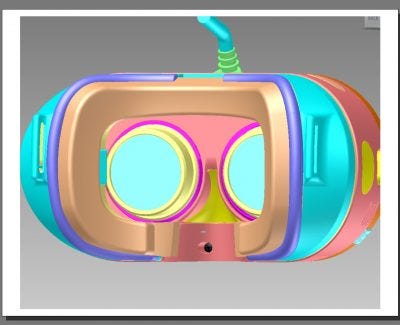
The face mask — the part that touches the user’s face — is easily removable and replaceable. It is designed with a groove (not shown in the picture) that allows an operator to quickly and accurately replace the mask when needed without requiring any special tools.
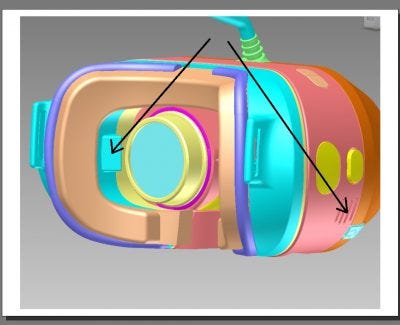
VR experiences can be very intense. For instance, guests to SEGA Joypolis run around in a special warehouse and shoot zombies. It is important to keep these guests cool and dry. That’s why we the public VR goggles include dual silent fans that whisk away humidity and heat.
The diagram has arrows pointing to an air vent (one in each side) and the holes through which it exits the goggles. An important feature in the Sensics design is the ability to separate the “passive part” of the goggles (facemask and head strap) from the “active part” (electronics, optics, etc.). This feature provides several important benefits:
- It allows guests to don the passive part while waiting in line. They can adjust the fit to their heads, and make sure the strap is comfortable. While doing so, the front part of the passive unit is completely open so guests can still see the real world, take a selfie with the strap. Only when the activity is about to begin does the operator attach the active part to the passive part.
- It permits various cleaning strategies for the passive part — the part that touches the head. For instance, an attraction operator can have many more passive parts than active parts and then clean the passive parts in batch at the end of the day.
- Separating the face mask from the active part of the goggles allows for multiple sizes of the face mask to fit kids, different facial structures and so forth.
The two parts of the goggles — active and passive — are illustrated in the photos below by Sensics team member Yaron Kaufman.
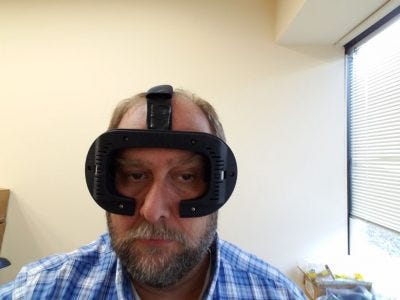
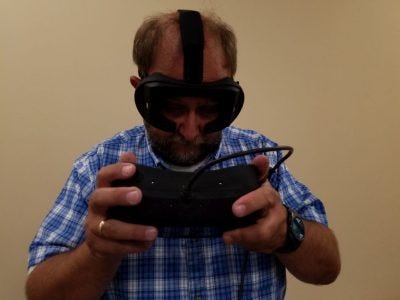
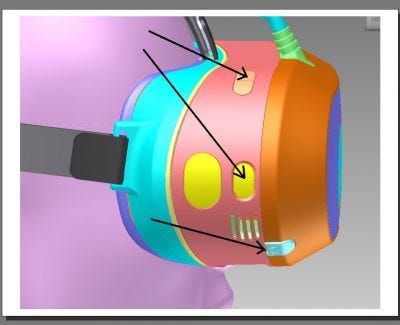
Detaching the passive part from the active part is done by pressing two button — one in each side of the goggles. The button is shown as yellow highlighted by the arrow in the diagram. The clasp holding the two parts together is made of metal, and thus designed for numerous grab/release cycles.
Two additional parts are highlighted in the diagram: configurable buttons on the top right side of the goggles serve as programmable user-interface controls. This could be to increase/decrease volume, to pause the game, select a menu item or any other function. The mechanical design allows for one, two or three buttons per the preferences of the customer.
Last, an audio output jack appear on the bottom. The goggles can also support a permanent audio solution which attaches where the large yellow ellipse is shown in the diagram to the right. We put a lot of thought into designing this product. We hope you will get a chance to try it and appreciate its suitability to public VR applications.
1 comment:
Well-written and excellent review. I really liked the article. Good comparison of home goggles and public goggles. Comfortable and replaceable parts has made the public goggles more useful. I read something similar about how to make virtual reality goggles, you can look at: http://www.techtyche.com/how-make-virtual-reality-goggles/
Post a Comment